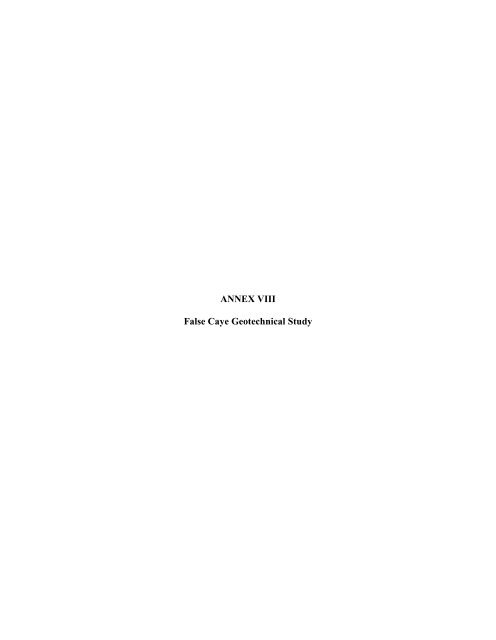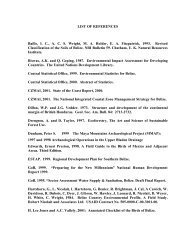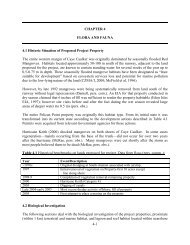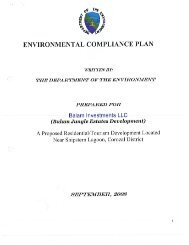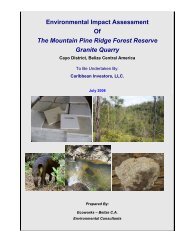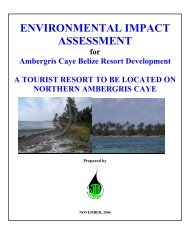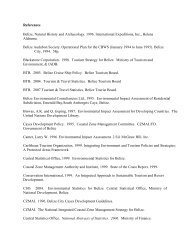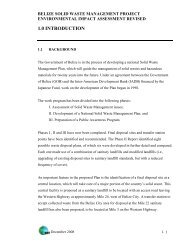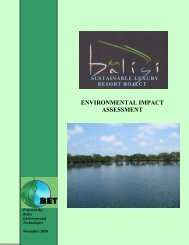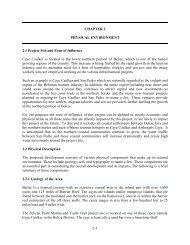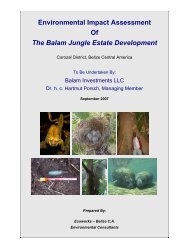ANNEX VIII False Caye Geotechnical Study
ANNEX VIII False Caye Geotechnical Study
ANNEX VIII False Caye Geotechnical Study
You also want an ePaper? Increase the reach of your titles
YUMPU automatically turns print PDFs into web optimized ePapers that Google loves.
<strong>ANNEX</strong> <strong>VIII</strong><br />
<strong>False</strong> <strong>Caye</strong> <strong>Geotechnical</strong> <strong>Study</strong>
1.0 Introduction<br />
1.1 Background<br />
1.2 Objective of <strong>Study</strong><br />
1.3 Overview of <strong>Study</strong><br />
2.0 Site Description<br />
2.1 Overall Site Setting<br />
2.2 Current Site Condition<br />
2.3 Site Topography and Drainage<br />
2.4 Natural Disaster Vulnerability<br />
3.0 <strong>Geotechnical</strong> Investigation<br />
3.1 Methodology<br />
3.2 Results<br />
4.0 Discussion and Recommendations<br />
4.0 General<br />
4.1 Significant Structures<br />
4.2 Roads and Pavements<br />
4.3 Site development<br />
APPENDIX I — Maps and Photographs<br />
TABLE OF CONTENTS<br />
Conceptual Map Showing lest Locations<br />
Aerial Photographs<br />
APPENDIX II — Standard Penetration resting Results<br />
…………...<br />
…………...<br />
…………...<br />
…………...<br />
…………….<br />
…………….<br />
…………….<br />
…………….<br />
…………….<br />
.....................<br />
…………….<br />
…………….<br />
.....................<br />
…………….<br />
…………….<br />
…………….<br />
________________________________________________________________________<br />
<br />
1<br />
1<br />
1<br />
1<br />
2<br />
2<br />
2<br />
2<br />
2<br />
3<br />
3<br />
3<br />
4<br />
4<br />
4<br />
4
1. INTRODUCTION<br />
1.1. Background<br />
Maya Island Resort (MIR) is proposing to construct a development on <strong>False</strong> <strong>Caye</strong>, a<br />
small island of approximately 65 acres, which lies off the southern coast of Belize near<br />
Maya Beach.<br />
The Architectural Rendering for the project indicates a development with some 32<br />
residential lots, an inland lagoon, natural reserves and trails, two spas and a large hotel<br />
complex. The concept allows for ample usage of naturally existing mangrove landscapes,<br />
particularly along the shore of the inland lagoon area.<br />
1.2. Objectives of <strong>Study</strong><br />
The overall purpose of the geotechnical study is to enable MIR’s architects to make<br />
decisions as to the type of construction that would be required on <strong>False</strong> <strong>Caye</strong>, and the<br />
challenges that they may face in constructing the kind of development that they have<br />
envisioned in their designs.<br />
The specific objectives of the Site Feasibility <strong>Study</strong> are to obtain standard penetration<br />
(SF1’) blow counts as close as possible to locations indicated by the client, and to<br />
determine soil profiles based on test pits. This information is then used to draw<br />
conclusions ad make recommendations for various civil engineering aspects of the<br />
project such as foundations for buildings and other structures, roads, etc.<br />
1.3. Overview of <strong>Study</strong><br />
The main trust of the geotechnical study was the performance of Standard Penetration<br />
Tests (SPT) in accordance with ASTM D1586 at various locations around the site. SPT<br />
probings were performed at a total of six (6) locations based on indications from the<br />
Client. Because actual coordinates and a scale map were not provided, points could not<br />
be placed with high precision; however a best-effort was made to mirror the client’s<br />
required locations, and ON readings was taken at each actual test location in the field.<br />
The test locations are also marked in the field with stakes and their corresponding<br />
numbers for easy reference back to the results.<br />
Pits were dug at selected locations near to SPT test probings in an attempt to determine<br />
the soil profile. Due to the fact that the soils were highly saturated and the water table<br />
very high overmuch of the site, this sampling was difficult. However, it soon became<br />
clear that the soil profile is very consistent over the island, down to a very large depth.<br />
________________________________________________________________________
2. SITE DESCRIPTION<br />
2.1. Overall Site Selling<br />
The site is comprised of a mangrove island of roughly 65 acres, situated roughly 2 miles<br />
off the coast of the Placencia Peninsula in Southern Belize. The island has a roughly oval<br />
shape with the northern end elongated towards the east. The coastline is swampy and<br />
mangrove-lined; however there are limited areas where there ale large boulders present.<br />
2.2. Current Site Condition<br />
At the time of the investigation, the Site was mostly covered by vegetation, most of<br />
which is mangrove. In addition, roughly 5O% of the site had some standing water<br />
(generally 3 to 8 inches, up to 24 inches in some areas). Two areas of the island,<br />
however, had deep bodies of water, as described in the following section.<br />
Soils under the standing water were firm enough to support the weight of human foot<br />
traffic; however the visually inferred consistency was of saturated, organic silt.<br />
23. Site Topography and Drainage<br />
This study has taken place during the rainy season, which typically lasts from June to<br />
December. As a result of this, the area had been subjected to significant amounts of<br />
rainfall, including during the geotechnical study, giving a good indication of the drainage<br />
situation.<br />
The island is flat and low-lying, and it is clear that drainage is currently poor from the<br />
extensive areas of standing water. The presence of mangrove vegetation is also an<br />
indication that the site holds significant amounts of water for long periods.<br />
As mentioned earlier, there are two areas where there are deep bodies of water. One area<br />
lies in the northeastern “panhandle” of the island, while the other, larger area lies in the<br />
center of the island. The aerial photographs in Appendix I show these areas clearly.<br />
Depth measurements were taken at the edge of these bodies of water; typically indicate a<br />
depth of 8 feet; however the angle of the drop-off indicates that much larger depths could<br />
be encountered in the middle.<br />
2.4. Natural Disaster Vulnerability<br />
Belize lies within the hurricane belt and is often targeted by significant tropical weather.<br />
The hurricane season lasts from June to November, more or less coinciding with the rainy<br />
________________________________________________________________________<br />
2
season. 1-lurricanes bring high winds, heavy rains and tidal waves in the case of<br />
the bigger ones.<br />
Because of the risks posed by hurricanes, it is recommended that important<br />
structures be designed for at least 120 mph wind speeds. Designing for higher<br />
wind speeds depends on the owner’s tolerance for risk or an analysis of the cost of<br />
alternatives such as appropriate insurance coverage. It should be noted that the<br />
Caribbean Uniform Building Code (CUBiC) gives a 50 -year return period<br />
hurricane wind speed of 121 mph for Belize based on 3-second gust; however it<br />
should also be noted that storm activity in the region has been higher in the past<br />
10 years or so than in the preceding 50 years, and Belize has experienced 2 storms<br />
with wind speeds above 130mph in just the past 5 years.<br />
Sustained periods of heavy rains can cause during hurricanes and tropical storms.<br />
In the case of <strong>False</strong> <strong>Caye</strong>, however, flooding as a result of rainfall is unlikely to be<br />
a major factor because of the interconnection of the internal bodies of water with<br />
the sea, which means that water levels will always tend to that of mean sea level.<br />
On the other hand, <strong>False</strong> <strong>Caye</strong> would be highly vulnerable to inundation from<br />
storm surge in the event of hurricane. Because of the small geographic extent and<br />
the flat topography of the island, such inundation would likely affect the entire<br />
caye in a very short period of time.<br />
CUBiC recommends a seismic Z value of 0.3, which corresponds to seismic Zone<br />
3 in the Uniform Building Code (California). This value can be used for seismic<br />
analysis of building structures.<br />
________________________________________________________________________<br />
3
3.0 GEOTECHNICAL INVESTIGATION<br />
3.1 Methodology<br />
A total of six (6) standard penetration tests (SPT) were performed for the geotechnical<br />
study. These tests were performed by subcontractor ATA Laboratories under the<br />
supervision of YEC, and formed the core of the site data used to form an opinion and<br />
recommendations for civil engineering works on the site.<br />
In locating SPT locations on the site, an effort was made to place them as close as<br />
possible to locations indicated by the client on a conceptual map of the island. It should<br />
be noted, however, that since coordinates were not given and the landmarks shown on the<br />
conceptual plan do not yet exist, it was not possible to ensure that the locations of testing<br />
in the field exactly match with those requested by the client. Nevertheless, as the map and<br />
photos show, the locations chosen should be close enough to those requested to provide<br />
the necessary information for the clients.<br />
SF1’ probings were performed in accordance with ASTM - D A drive weight assembly<br />
consisting of a metal hammer, hammer fall guide, anvil and hammer release system is<br />
used to drive a standard sized probe into the soil. The hammer is dropped by free fall<br />
from a specific height in order to impart a consistent amount of energy to the probe, and<br />
the distance the probe moves through the soil is recorded. The so-called “N-Value” is the<br />
number of blows needed to drive the probe over the depth interval of 6 inches. This gives<br />
an indication of the resistance of the soil, which can then be correlated to bearing<br />
behavior of the soil for foundation design.<br />
Soil was manually sampled at several locations to enable a determination of the soil types<br />
present on site. This also assists in correlating SF1 blow counts to the bearing capacity of<br />
the soils encountered.<br />
3.2 Results<br />
SFT probings on the island reveals low bearing capacity soils to a large depth over all<br />
areas tested. Refusal was encountered in only one location, at TP3, which is on the<br />
western part of the island (please refer to map). This refusal was encountered at 27 feet 8<br />
inches below grade, however the nature of the refusal leads the consultant to suspect that<br />
it is the result of a localized formation rather than an extensive bedrock layer.<br />
At TP l, which is near the northeast tip of the island, there was zero resistance down to a<br />
depth of 14 feet, followed by an avenge N-Value of 5 down to a depth of 23 feet. This<br />
resistance then decreased to an avenge N-Value of 3 do to the rig’s maximum depth of 40<br />
feet.<br />
________________________________________________________________________<br />
<br />
4
At TP2, located in the north central area of the island, there was zero resistance<br />
down to a depth of 7 feet, followed by very low resistance, on the order of 2 to 4<br />
blows per foot N-Value, down to a depth of 40 feet.<br />
At TP3, located on the west side of the island as mentioned earlier, there was low<br />
resistance, with N-Values on the order of 2 to 3 blows per foot, down to a depth<br />
of 23 feet before abruptly increasing to 13 blows per foot, followed by refusal at<br />
27 feet below the surface.<br />
At TP4, located near the center of the island, them was low resistance with N-<br />
Values on the order of 1 to 2 blows per foot all the way down to the maximum rig<br />
depth of 40 feet.<br />
At TP5, located in the south-central portion of the island, resistance was on the<br />
order of I to 2 blows per foot all the way down to the maximum rig depth of 40<br />
feet, with the exception of an area between 26 and 28 feet where the N-Value was<br />
6 to 8 blows per foot.<br />
At TP6, located near the southern coast of the island, resistance was low with N-<br />
Values of 2 to 3 blows per foot down to a depth of 30 feet, at which depth<br />
resistance increased sharply to 16 blows per foot. This resistance continued at 8<br />
blows per foot down to a depth of 34 feet, before failing back to 3 blows per foot<br />
all the way down to 40 feet.<br />
Soil samples retrieved indicates that soil profile is consistent from the surface<br />
down well past depths for shallow foundations, and are typically saturated organic<br />
silt with varying amounts of sand mixed in.<br />
The detailed results of soil testing can be found in Appendix II.<br />
________________________________________________________________________<br />
5
4.0 DISCUSSION & RECOMMENDATIONS<br />
4.1 General<br />
As can be seen from the soil testing results described in Section 3 above, the soils in the<br />
upper and middle levels on <strong>False</strong> <strong>Caye</strong> have low bearing capacity. Because of the type of<br />
soils encountered (organic silt) and the very low blow counts received, it is not advisable<br />
to place foundations for significant structures to bear on these soils. Not only are the<br />
bearing capacities very low, but also the properties of organic soils are unreliable and<br />
often change over time as matter decays. For roads and pavements, the loading is much<br />
less concentrated than for structures and the tolerance for differential settlements much<br />
larger. Nevertheless, thoughtfully site preparation would be required to ensure that roads<br />
have an acceptable level of performance and durability, as discussed in more detail<br />
below. Attention must be paid to drainage since the site is low and swampy, and finally<br />
any underground conduitry and piping for utilities will have to take into account the<br />
nature of the soils.<br />
4.2 Significant Structures<br />
It is clear from the results of the soil testing that significant structures will require piled<br />
foundations. Additionally, refusal appears to be in excess of the 40-foot maximum for the<br />
rig used by the testing laboratory. SPT blow counts are generally irrelevant for these<br />
depths since shallow-type foundations (i.e. spread footings, strip footings, etc.) cannot be<br />
built economical at these depths. Because of the uncertain depth to refusal, it would be<br />
recommendable to utilize piles that would be stable while being driven over these depths<br />
in poor soils, as well as piles that could be lengthened as necessary during the driving<br />
process. Steel H-piles would likely fit these requirements better than concrete piles, since<br />
sections could be welded on as necessary. Because of the depths to refusal, timber piles<br />
would not be practical for this site.<br />
4.3 Roads and Pavements<br />
As noted, roads and pavements can be built on soils with lower bearing capacity than for<br />
significant structures. Nevertheless, the soils in the upper layers of <strong>False</strong> <strong>Caye</strong> have<br />
bearing capacity that must be considered negligible, and this taken with the soil type<br />
encountered means that undercutting would be recommended before construction of<br />
roads or pavements. Between 5 and 10 feet of poor soil should be removed from the areas<br />
to be constructed upon, and replaced with fill meeting detailed engineering requirements,<br />
properly compacted. The specification for fill should be prepared by a qualified civil<br />
engineer with experience in road works. If this undercutting is not done, there is a high<br />
probability of large settlements, potholing, and generally poor performance in roads and<br />
pavements. Even with the undercutting, particularly if the<br />
6
depth of undercutting is on the low side, it is recommendable to design roads and<br />
pavements with appropriate jointing to facilitate moderate differential settlements.<br />
4.4 Site Development<br />
The conceptual plan of the island indicates an intention to subdivide into lots of<br />
various types. As previously discussed, any significant structures on these lots<br />
should be piled. In addition, however, fill works should be done on the lots to<br />
ensure that proper drainage takes place. This will also facilitate such small-scale<br />
site works as driveways and walkways. It is strongly recommended that a<br />
comprehensive drainage system be designed for the entire island, ensuring<br />
positive drainage from all occupied areas.<br />
The conceptual plan of the island also indicates some pier and mooring structures<br />
to be constructed in bodies of water. Because of the nature of the island, the<br />
methodology for such construction would be very similar to all other parts of the<br />
island, which is to say very deep piled foundations.<br />
Finally, for underground utilities such as water pipes and electrical conduits,<br />
trenching should be properly designed to avoid large settlements that can break<br />
pipes, particularly in the case of water and wastewater piping networks.<br />
________________________________________________________________________<br />
7
Appendix I - SPT bore hole location
Appendix II – Bore Hole Report


